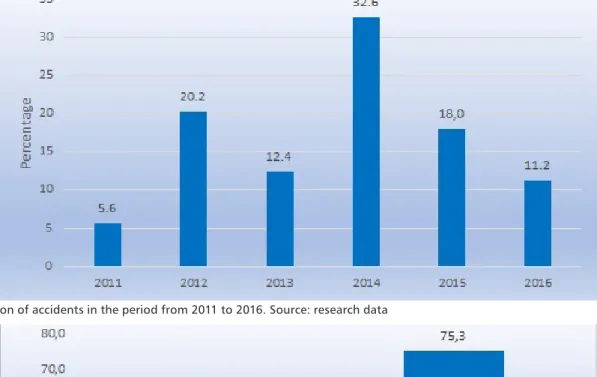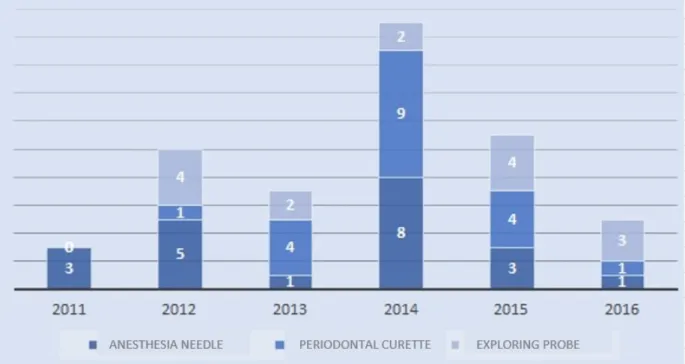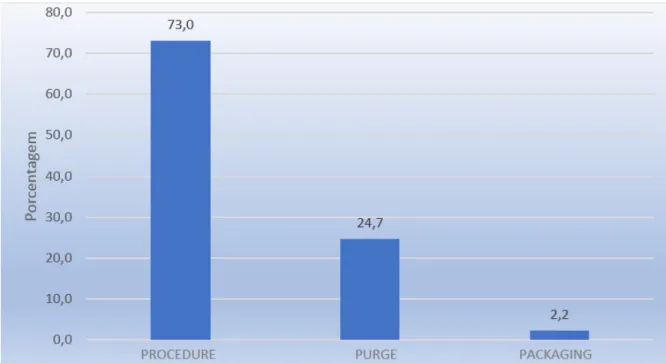DOI: http://dx.doi.org/10.18363/rbo.v75.2018.e1077 Original Article/Biosafety
Evaluation of the occurrence of sharp instrument
accidents in a clinical Dentistry School
Vanessa Pereira Gonçalves de Souza,1 Valéria Cristine Engrácio Borges,1 Orlando Francisco Barbosa Nascimento,1 Jéssica Thayse Virginio Alcântara Duca,1 Denise Rodrigues Cavalcanti Veras,1 Olívia Maria Guimarães Marroquim,1 Aurea Valéria de Melo Franco1
1School of Dentistry, Centro Universitário Cesmac, Maceió, AL, Brazil
• Conflicts of interest: none declared.
AbstrAct
Objective: to evaluate the occurrence of occupational accidents with undergraduate dentistry students from the 5th to 10th period of Centro Universitário Cesmac. Ma-terial and Methods: analysis of the notification forms of accidents with exposure to blood or other biological maMa-terials, between the years of 2011 to 2016, available
on the Biosafety Committee of Centro Universitário Cesmac. Results: we observed that the highest number of accidents occurred in 2014 and that the most common instruments were the needle of the carpule syringe, followed by the periodontal curette. Most accidents occurred during the moment of care. Conclusion: the students were submitted to the experience of accidents with potential of biological contamination because of sharp instruments. Strengthening prophylactic measures is needed to reduce such circumstances that are detrimental to the health of those involved in the patient and student relationship.
Keywords: Prevention of accidents; Exposure to biological agents; Risk management.
Introduction
O
ccupational diseases are changes in the health of workers developed during the performance of the profession and in function of the execution of its service. Since health professionals are exposed to biological agents and in direct contact with vectors that transmit infectious diseases in their work environments, it is not uncommon for them to be affected by them.1Occupational accidents are explained as damages that occur during activities held in the work environment, causing functional alteration, with or without bodily in-jury to the worker.2
In general, labor activities expose workers to varying occupational risks. These risks of accidents include
phys-ical, chemphys-ical, ergonomic and biological agents.3Dental
teams are under constant risk of contamination by in-fectious agents due to their field of work and the instru-ments that are used.4
Accidents usually occur because of needles or cutting instruments; by direct contact of the ocular, nasal, oral mucosa and non-intact skin with contaminated blood or organic materials; thus, being potentially preventable.5
Given the field of work of dental surgeons and their assistants who have the oral cavity as a place of direct action, which presents small dimensions, difficult access and different colonizing microorganisms, the biological risk is essentially caused by contact with saliva, blood and other organic secretions.6
According to Sassamoto et al.,6 universal measures for
interrupting the transmission chain of microorganisms are needed; thus, providing reduced occupational risk to the professional. For Glaber,7 biosecurity measures
pre-vent accidents and cross-contamination between the den-tal surgeon and the patient.
Such biosafety measures are universal standards aimed at reducing exposure to biological materials. They should be used when handling medical-hospital instruments and in the care of all patients, regardless of a confirmed or presumed diagnosis of infectious disease, such as HIV/ AIDS, hepatitis B/C and others.5
Biosecurity measures in dentistry clinics begin with a thorough user’s anamnesis, use of Personal Protec-tive Equipment (PPE), correct and thorough washing of hands, use of surgical gloves depending on the procedure to be performed, preparation, disinfection and steriliza-tion of the instruments, correct practice of ergonomics and appropriate disposal of organic waste, in addition to
the vaccination of the entire oral health team.8,9
Periodic training on biosafety standards makes profes-sionals more committed to safety since these processes involve more responsibility, discipline, knowledge and organization of the individual, than complex reasoning
and techniques that are difficult to perform.9
There are over 20 types of confirmed diseases that can be acquired through puncture-cutting contamination described in the literature; the most common and most important are hepatitis B, hepatitis C, and HIV due to
their severity.8
Contamination accidents must be treated as medical emergencies, given that if it occurs, taking the prophylac-tic measures immediately after exposure is criprophylac-tical. These are summarized in: excessive washing of the place with soap and water, notification of the accident, collection of blood samples from the source patient and treatment
ac-cording to the diagnosis.10
Filling the form with the most complete information possible is fundamental when a professional is exposed to a risk. Thus, the protocol followed by the injured profes-sional can be found and the risk of future problems can be minimized by conducting studies on the development of strategies focused on aiding students to become aware of the practices of risk of exposure to occupational infec-tious diseases.2
According to the World Health Organization (WHO), health professionals are three to six times more likely to contract hepatitis B when compared to the general popu-lation.11 In addition to the use of PPE, immunization can
also prevent contamination in the dental work environ-ment. For example, hepatitis B and tetanus vaccines pro-tect health professionals and students of the area from contracting such diseases from 90% to 95%.12
In Brazil, studies on occupational accidents and bio-safety among health professionals are still scarce when
compared to studies conducted in different countries,10
which justifies encouraging and performing studies on prophylactic measures and awareness-raising of dental
teams. Although undergraduate Dentistry students being
one of the most exposed groups to occupational accidents with biological material, there are very few studies on this topic, since most of are performed by nursing and surveillance teams. However, dentistry professionals and academics must know about the diseases, as well as their
transmission routes so they can adequately protect
them-selves.
Biosafety education is essential for the correct training in Dentistry courses. Special attention to the routines of academics involved in dental health care and the admin-istration of occupational accidents will provide strategies of care and review of non-operational systematic proto-cols in university and professional practice.13
Complex procedures that expose the team to varied risks are performed in dentistry practice. One of the main risks at work involves sharp instruments and bio-logical material; thus, the dental surgeon and his or her auxiliary team must be prepared to deal with possible work accidents, notifying them and acting according to the protocol recommended by the Brazilian Ministry of Health.11,13
The objective of this study was to evaluate the
oc-currence of occupational accidents with students of the undergraduate Dentistry course of Centro Universi-tário Cesmac. For such, it was necessary to determine the frequency of accidents with sharp instruments in the Dentistry Clinic, as well as to quantify the number of accidents and verify the circumstances in which they occurred.
Material and Methods
This research was previously submitted and approved by the Research Ethics Committee on human beings of Centro Universitário Cesmac, in accordance with Reso-lution 196/96 of the Brazilian National Health Council, CAAE: 55995716.7.0000.0039; Opinion 1,606,039.
This is a retrospective, observational and descriptive study. Data were obtained from the forms filed in the Comissão de Biossegurança (Biosecurity Comission – CBioss) of Centro Universitário Cesmac, from 2011 to 2016, filled when the accident had occurred. From these data it was possible to identify the instruments involved, the locations where the accidents occurred, and the main circumstances surrounding the occupational accident.
The study population consisted of students, from the 5th to 10th period, who were performing the practical disciplines of the dentistry course, in contact with biolog-ical material and the use of sharp instruments. Students are subject, at some point in their academic career, to un-dergo some kind of accident with sharp instruments.
Data were placed into a Microsoft Excel worksheet. The Statistical Package for Socials Science (SPSS) soft-ware, version 20.0 and Descriptive Statistics were used for the statistical analysis, including the calculation of means and standard deviations, distribution of simple and percentage frequencies and presentation of results through figures. Inferential Statistics was used to com-pare group means.
Results
Data of this research were obtained from accident no-tification forms caused by sharp instruments, filed at the Biosafety Commission (CBioss) of Centro Universitário Cesmac, from 2011 to 2016, filled at the time of the acci-dent and corresponding only to reported acciacci-dents. We can thus suppose that the numbers found are a lower esti-mate than the lived reality, since occupational exposures to biological material are not always reported.
In the period from 2011 to 2016, n=89 accidents with sharp instruments were reported in the Dentistry Clinic, with n=5 in 2011, n=18 in 2012, n=11 in 2013, n=29 in 2014, n=16 in 2015 and n=10 in 2016. Data show in Figure 1 in percentage.
Of this number of accidents, victims were mostly wom-en, n=67 (75.3%) in total, when compared to n=22 (24.7%) of men, as found in Figure 2.
According to the notification forms, among the 89 accidents that occurred, the hands were the main sites affected, n=77 (86.5%) in total, followed accidents in the arms, n=3 (3.4%). The affected sites were not reported in n=9 (10.1%) forms that registered accidents caused by sharp instruments, as seen in Figure 3.
Figure 1. Distribution of accidents in the period from 2011 to 2016. Source: research data
Figure 2. Distribution of accidents according to the student’s gender from 2011 to 2016. Source: research data
The main instruments that caused injuries were needles n=25 (28.1%), periodontal curette n=22 (24.7%) and explor-atory probes n=15 (16.9%), followed by other instruments such as drills, endodontic files and surgical instruments, as shown in Figure 4.
In 2011 and 2012, the most common instrument were needles, found n=3 accidents in 2011 and n=5 in 2012; In
2013 and 2014, the most common instrument were the peri-odontal curettes, reported in n=4 accidents in 2013 and n=9 accidents in 2014, followed by n=8 with anesthesia needle; in 2015, accidents with the exploratory catheter and anesthesia needle showed equal values, n=4 accidents; and, in 2016, it was verified that the main instrument was the exploratory probe, n=3 accidents, as shown in Figure 5.
Figure 4. Distribution of accidents according to the instruments used from 2011 to 2016. Source: research data
Discussion
When comparing the number of accidents from 2011 to 2016, 2014 had the highest number of reports of occupation-al accidents among undergraduate dentistry students. There is no explanation for the increase in notifications in 2014, since the filled forms do not provide full information about the accident.
However, we must highlight the preparation of the Man-ual de Biossegurança do curso de Odontologia do Centro Uni-versitário Cesmac (Biosafety Manual for the undergraduate Dentistry course of Centro Universitário Cesmac) in 2015, which regulates and standardize the internal activities of clinics and laboratories with the objective of standardizing, guiding and offering practicality regarding the required and mandatory Biosafety procedures in dentistry, based on sci-entific research and guidelines of appropriate Brazilian and international bodies.5 This could possibly be a reason for the
reduction of accidents in the following years.
Regarding gender, a similar result was observed in the study by Sassamoto et al.,6 who attributed the fact to the
greater number of women in the profession, and disagreeing In this study, most reports of accidents caused by sharp objects occurred during dental procedures, corresponding to 65 accidents (73.0%), when performing: anesthesia, scrap-ing, suturscrap-ing, surgical procedures, cleaning and moving in the room. In other circumstances, such as a staying in the purge environment, n=22 accidents were observed (24.7%). During material packaging, n=2 accidents (2.25%) were re-ported, as shown in Figure 6.
Figure 6. Distribution of accidents according to the procedure performed. Source: research data
with Andrade et al.,4 whom obtained a greater number of
occurrences for men.
Regarding the site of the accidents, the result found is quite similar to other studies, corroborating the study by
Nascimento et al.14and Lima et al.12 which cite the hands as
a whole as the most affected region observed in accidents, which is easily justified by the type of activity developed in dental practice due to having the oral cavity as a direct field
of work, with small dimensions, difficult access and colo-nizing microorganisms,6 confirming the professional risk of
the dental surgeon during intra and extraoral procedures. No ocular accidents were found in this research, unlike what was found in Ribeiro et al.,15 in which the most affected
body region were the eyes (53.3%). Possibly, this type of ac-cident occurs due to lack of use of protective goggles, a prac-tice still little incorporated in routine Dentistry activities.
Regarding the instruments that caused injuries, our re-sults are similar to the study by Artuzi et al.,16 in which
the most common instrument was the periodontal curette (28%) and anesthetic needles (26%). In the study by An-drade et al.,4 the exploratory probe was the instrument with
the highest number of lesions (54.2%), followed by needle (45.8%), drill (29.2%) and endodontic file (20.8%).
According to Lima et al.,13 it can be assumed that the
stu-dent’s relationship with the patient generates anxiety and nervousness, being related to the greater number of occur-rences when performing care procedures, followed by wash-ing and drywash-ing of the instruments, and these last two mo-ments may be associated with haste.
10. Orestes-Cardoso SM, Farias ABL, Pereira MRMG, Orestes-cardoso AJ, Cunha Junior IF. Acute injuries: prevalence and prophylactic measures among dental students. Rev. Bras Saúde. Ocupacional. 2009;34(119);6-14.
11. Barbosa MVJ, Souza AM, Carvalho LPF, Hernandez RVT, Megda S. Incidence of accidents with perforating materials and body fluids at the university hospital “Alzira Velano” Alfenas-MG. Rev. Un. Alfenas. 1999;5(2);221-5.
12. Lima LKOL, Tipple AFV, Barros DX, Ferreira OS, Paiva EMM, Simões LLP. Accidents with biological material among dentistry students in the State of Goiás of Teaching Institutions. Rev. Odonto. Brasil-Central. 2012;21(58);553-9. 13. Lima AA, Azevedo AC, Fonseca AGL, Silva JLM, Padilha WW. Occupational Accidents: Knowledge, attitudes and experiences of dentistry students of the Fed-eral University of Paraíba. Rev. Bras. Odontopediatria. 2008;8(3);327-32. 14. Nascimento LS, Assunção LRS, Silva Júnior NG, Pedreira EM, Silva RLC. Accident with sharps at the Dental School of UFPA: Visualization of a Scenario. Rev.Odonto. Brasil-Central. 2012;21(56);463-7.
15. Ribeiro PHV, Hayashida M, Moriya TM. Accidents with biological material among undergraduate dentistry students. Rev. Odonto. Universidade. Cidade. SP. 2007;19(3);263-8.
16. Artuzi FE, Bercini F, Azambuja TF. Acute injuries at the Faculty of Dentist-ry of the Federal University of Rio Grande do Sul. Rev. Faculdade. Odonto. PA. 2009;50(2);26-9.
References
1. Miotto MHMB, Rocha RM. Occupational accident by sharps material among dental academics. Rev Bras Promoç Saúde. 2012;25(1);97-102.
2. Silva JA, Almeida AD, Paula VS, Villar LM. Biological accidents research among health professionals. Rev Enferm. 2009;13(3);508-16.
3. Bezerra ALD, Souza MNA, Feitosa ANA, Assis EV, Barros CMB, Carolino ECA. Biosafety in dentistry. Arq Bras Ciências Saúde. 2014;39(1);29-33.
4. Andrade RRA, Almeida RAC, Sampaio GC, Pereira JRD, Andrade ESS. Oc-currence of accidents with sharp instruments in a dental clinic in the city of Re-cife-Pernambuco. Estudo Piloto. Rev Cirurgia BMF. 2013;13(2);87-100. 5. Manual of Biosafety of the course of Dentistry of the University Center Ces-mac. Maceió, 2015;89.
6. Sasamoto AS, Tiplle AFV, Leles CR, Silva ET, Paiva EMM, Souza CPS et al. Profile with Biological Material in a Dental Education Institution. Rev Odonto Brasil-Central. 2010;19(50);251-7.
7. Glaber IG, Freitas NA, Giuberti NC, Morte RPB, David IA, Salim M, et al. Pre-vention and occurrence of sharps injuries among dental professionals in the city of Vila Velha / ES. Rev Bras Odontol. 2012;69(2);174-9.
8. Brozoski MA, Traina AA, Naclério- Homem MG, Deboni MCZ. Occurrence of sharps accidents in a dentistry course. Rev.Gau.Odontol. 2009;58(1);77-80. 9. Freitas RR. Biosafety in dentistry. [tese]. Minas Gerais: Universidade Federal de Minas Gerais, Programa de Pós-graduação em Saúde da Família, 2012.
Submitted: 02/15/2018 / Accepted for publication: 05/25/2018
Corresponding Author Aurea Valeria de Melo Franco
E-mail: aureavaleriamelo@hotmail.com
Mini Curriculum and Author’s Contribution
1. Vanessa Pereira Gonçalves de Souza – Academic. Contribution: effective scientific and intellectual contribution; data collection; data interpretation; preparation of the manuscript; writing of the manuscript. ORCID: 0000-0003-4365-797X
2. Valéria Cristine Engrácio Borges – Academic. Contribution: effective scientific and intellectual contribution; data interpretation; preparation of the manuscript; writing of the manuscript. ORCID: 0000-0003-0501-6004
3. Orlando Francisco Barbosa Nascimento – Academic. Contribution: effective scientific and intellectual contribution; data interpretation; preparation of the manus-cript; writing of the manuscript. ORCID: 0000-0002-1256-5274
4. Jéssica Thayse Virginio Alcântara Duca – Dental surgeon. Contribution: effective scientific and intellectual contribution; data interpretation. ORCID: 0000-0002-2471-7386
5. Denise Rodrigues Cavalcanti Veras – Dental surgeon, academic. Contribution: effective scientific and intellectual contribution; data interpretation. ORCID: 0000-0003-1317-6972
6. Olívia Maria Guimarães Marroquim – MSc. Contribution: coordination and elaboration of the project; data analysis; writing of the manuscript. ORCID: 0000-0002-4666-4385
7. Aurea Valéria de Melo Franco – MSc. Contribution: coordination and elaboration of the project; training; registration in Plataforma Brasil and proceedings with the Research Ethics Committee; data analysis; writing of the manuscript. ORCID: 0000-0002-5966-8617
According to the literature, 55% of the accidents occur during at the post-care period, with 57% occurring during the washing of the instruments, in which the lack of atten-tion was the main reason for the evaluated cases.13 However,
data of this research corroborate with the results found in Orestes-Cardoso et al.,10 when analyzing the moment when
these accidents occurred, we can observe that during clin-ical care students were more susceptible to exposure, with 18.0% occurrence, when compared to 14% of accidents oc-curred after this activity.
According to Orestes-Cardoso et al.,10 some studies on
exposure to potentially contaminated biological material
among dentistry students indicate that the lack of clinical experience is an aggravating factor, in addition to the cer-tain characteristics of the course such as nervousness, anx-iety and constant supervision of professors as evaluators, factors that increase the risk of accidents among students.
Conclusion
The presented results indicate the need for the continued education on biosafety control during undergraduate clin-ical training to reduce situations detrimental to the health of those who are involved in the relationship between the patient and the student.


